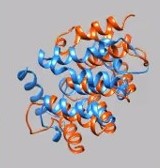Method of the year 2021 has been decided by Nature Methods to be protein structure prediction by artificial intelligence (deep learning)-based methods. Protein structure prediction is chosen as method of the year for the remarkable levels of accuracy achieved in predicting the 3D structures of proteins and protein complexes, essentially solving this long-standing challenge.
The potential to predict protein three-dimensional (3D) structures given a linear sequence of amino acids has captivated computational biologists for decades. While considerable progress had been made in the field, no approach had been able to reliably produce models that approached, let alone matched, the quality of experimentally determined structures. In the past year, the deep-learning-based methods AlphaFold2 and RoseTTAfold have managed to achieve this feat over a range of targets, forever altering the course of the structural biology field. More impressively, a collaboration between the European Molecular Biology Laboratory and DeepMind has predicted structures for over 350,000 proteins for 21 model organisms and made them freely available at the AlphaFold Protein Structure Database — with plans for expanding predictions to millions of structures in 2022.
None of this would have been feasible without the availability of a large volume of experimental structural data serving as a training data resource for deep learning. Over the past 50 years, structural biologists have arduously solved the structures of over 170,000 proteins and openly shared these in a central macromolecular data archive, the Protein Data Bank (PDB). Fortuitously, this decision to openly share data at a time when data repositories were hardly the norm turned out to be one of the best investments for the field.
A new computational race has started. Both AlphaFold and RoseTTAFold have been further optimized to predict multi-protein complexes. Several other preprints are available that extend the AlphaFold method or apply it to more specific problems, such as predicting protein dynamics and ligand binding. Deep learning is also making an impact on the RNA structure prediction field.
Now that it is possible to predict accurate structures for the large majority of proteins, what lies in the future for experimental structural biology? More important, what is the impact on the application of knowledge to the various aspects of life: medicine, agriculture, etc.?
Source: Method of the Year 2021: Protein structure prediction. Nat Methods 19, 1 (2022). https://doi.org/10.1038/s41592-021-01380-4
